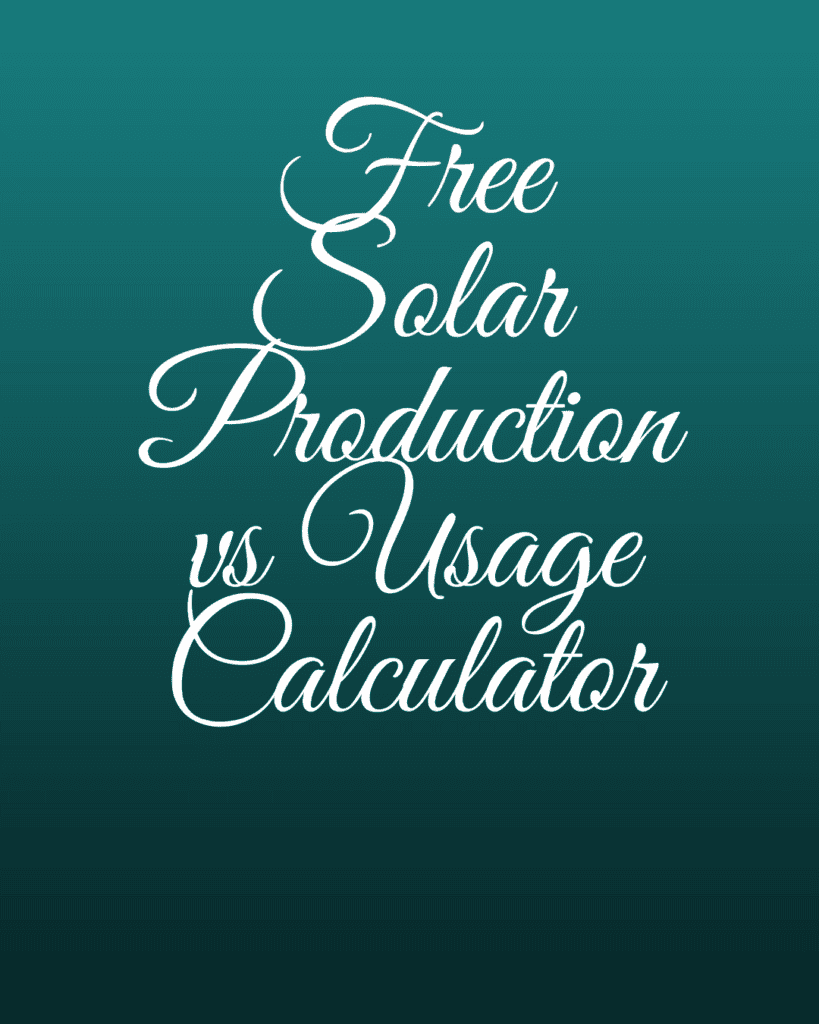Solar Production vs Usage Calculator
Free Solar Production Vs Usage Calculator
If you want to reduce your electricity usage significantly, a solar calculator could be just what’s needed. These tools typically request your average monthly energy usage in Kilowatt-Hours (kWh).

Multiply this number by your region’s production ratio based on average sunlight levels and weather patterns, to get your kW capacity requirement.
How it works
An effective solar panel calculator can assist in selecting the appropriate size and number of panels for your electricity usage at your location. It will ask some basic questions regarding energy consumption, peak sunlight hours in your area (which may differ), rebates/incentives available locally as well as potential savings with solar in your home. Your responses will provide an unparalleled picture of both how solar can reduce costs as well as opportunities to save more with its use in your home.
Your energy consumption, measured in kilowatt-hours (kWh), is one of the key pieces of data required by a solar calculator. The tool will ask how many kWh are consumed daily as well as annually before using this information to estimate how much power can be generated by your system on average.
Calculating solar production involves dividing your home electricity consumption by the average daily solar production ratio in your region, which varies according to state. Enter your electricity usage into the calculator and locate your state on the map to find this ratio; for instance, households consuming 15,000kWh annually in California might require 6 kW solar panel systems, whereas comparable usage in Massachusetts might require an 8-kW system.
Alternatively, if your system can’t produce enough energy to offset your home energy needs, any excess power produced will be put onto the grid in exchange for credit from the utility company – this process is known as net metering and provides an effective way of offsetting utility costs by reducing monthly energy costs while avoiding paying for power you aren’t using.
Net metering is only available in states with favorable electricity rates, though. Some offer fixed fees that cannot be offset with solar while others have time-of-use rates that don’t favor them as much. A reliable solar calculator will take into account both local electricity rates and incentives such as federal tax credits to give an accurate estimation of potential savings.
Calculate your energy savings
Once you know how much solar energy your system will produce, compare that against how much electricity you consume to calculate how many kilowatt-hours of savings each month by making the switch to solar. Savings depend on multiple factors – location, average daily peak sun hours in your region and panel efficiency (the more efficient they are the more electricity they can produce per hour).
This calculator can help you estimate the size and payback time for your solar power system, commonly referred to in industry circles as its payback time. Your payback period may differ from person to person but there is a formula you can use to estimate it: first add together your upfront costs of installing solar power systems before subtracting any tax credits, rebates or incentives eligible to you before adding up annual electricity bill savings and dividing that figure by total system cost to calculate how long it’ll take your system to cover itself in terms of years.

Another factor that can impact your payback time is whether or not you plan to sell any excess solar energy back to the grid. Some electricity providers such as Rhythm offer buyback tariffs for solar customers that allows them to sell back any extra energy they produce; this may help maximize energy savings; however, before agreeing on such an option it’s essential to investigate their offer of compensation; otherwise it might be more economical to store the surplus and lower utility bills directly.
No matter your individual circumstances, solar will almost certainly reduce your electricity bills and offer significant returns. While the exact savings amount varies based on individual circumstances, most systems pay for themselves within 10 years and provide years of free electricity thereafter. Comparing quotes is key here – find an installer you trust who can answer all your queries about how solar can benefit you!
Calculate your payback time
Solar payback periods provide a critical measure for estimating when energy savings will outweigh upfront costs of going solar, taking into account your initial investment, annual financial benefits like eliminating electricity bills and any available upfront and ongoing incentives. To calculate this number simply divide total costs by annual savings to get your solar payback period timeframe.
Start with your system cost, before any available solar rebates and incentives like a 30% federal tax credit or Solar Renewable Energy Certificates (SRECs). Subtract their value and then add in annual energy savings resulting from rooftop solar installations; these could include reduced electricity bills from rooftop installations as well as any annual incentives such as SRECs or net metering credits that you receive annually.
Subtract the total annual costs from savings to calculate the solar payback period in years. On average, EnergySage customers break even within seven years, though this timeframe may differ depending on your energy use, price of electricity from your local utility company, upfront solar incentives available and ongoing incentives that you may take advantage of.
Example: In Colorado, where Xcel offers a 1-to-1 credit for each kWh of solar electricity you contribute back into the grid, you could save around $1350 annually by installing solar. Assuming your system costs after incentives total $20,552, and you spend $2,895 each year on electricity usage (7.1 years = $20552/2895) this system would pay for itself after seven years (using 20552/ $2895 as its breakeven point).
Note that this example is just an estimate and your individual results may differ. What really matters here, however, is your state’s rate of electricity price increase: in states with higher rates, solar payback times will take longer.
No matter your current electricity rates, a home solar power system should always be considered as an option. Not only can it save on bills; its installation could even increase its value as potential buyers consider not only its current worth but its total worth as well.
Get a free quote
Utilizing a solar energy calculator is the ideal way to assess your home’s electricity consumption and the ideal system size that would meet it. Simply answer some simple questions about location and usage to activate the calculator’s report showing just how much value there could be in making the switch to solar power.
Once you know your monthly energy consumption, the solar panel calculator will assist in estimating how much electricity a solar system could produce each year based on how much sunlight falls on your home.
Solar calculators can also estimate the potential savings that could result from switching to solar energy providers, while some even recommend installers and financing options that best suit your unique requirements – this can save time and make the transition simpler!
Some solar calculators will also estimate your potential payments from the Smart Export Guarantee (SEG), a tariff that rewards solar panel owners who send excess power back into the grid. It is mandatory for new generation PV systems and offers various payment plans, so be sure to explore your options thoroughly before making a decision.

Some solar calculators also provide a rooftop solar preview tool, which shows what a solar installation would look like on your roof. This feature is especially beneficial to homeowners and business owners considering going solar but have yet to commit to an installer; taking into account factors like building layout, rooftop dimensions and azimuth to provide an accurate calculation of their potential solar potential. Solar companies can add this tool as lead gen and conversion tool onto their websites or use it with customers as a more accurate picture of costs and energy savings associated with installing a system.
